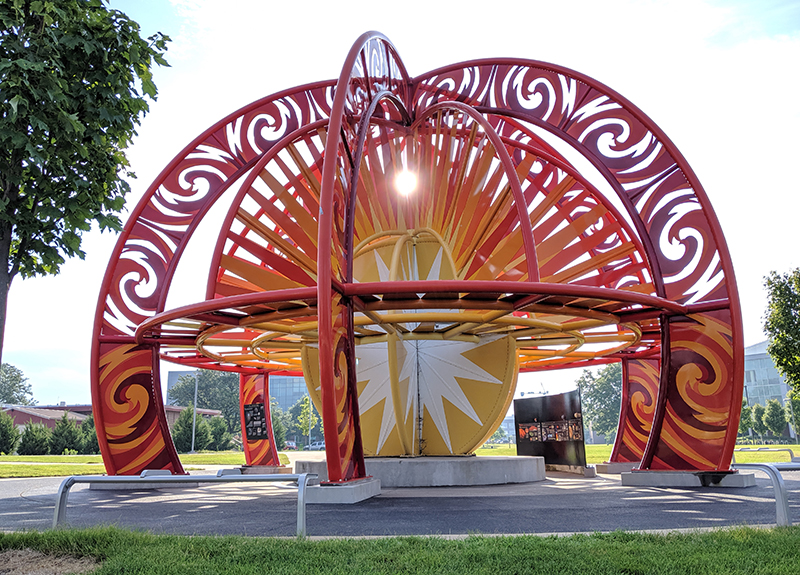Space walking
Space Walks tours take visitors to Purdue’s best-known space sites

A student project to highlight Purdue’s distinguished history in space exploration includes little-known facts that hold an element of surprise for everyone – even members of one of the University’s most prominent NASA families.
Amy Ross (BSME 1994, MSME 1996) – a NASA spacesuit designer and daughter of Purdue astronaut alumnus Jerry Ross (BSME 1970, MSME 1972) – proved that to Angelica Duran’s English 413 (Studies in Literature and History: From the Heavens to Outer Space) students this spring.
As part of their coursework, 14 students created a series of walking tours to help visitors locate campus landmarks that illustrate why Purdue is known as the “Cradle of Astronauts.” When Ross visited campus in April to participate in a panel discussion, she took a beta version of the students’ “Purdue Space Walks” map out for a spin.
“She went on some of the walks and said that when she was a student here, those buildings were there and she had never known that some of the things existed. It was very exciting,” said Duran, a professor of English, comparative literature, and religious studies. “If that had been the only thing that happened, that we did that for her, I would have been golden.”
This summer, the first published versions of the maps became available to all, coinciding with the 50th anniversary of the Apollo 11 mission when Purdue alumnus Neil Armstrong became the first human to set foot on the lunar surface.
The tours direct visitors to some of Purdue’s best-known space sites, like the moon-boot footprints and statue outside Neil Armstrong Hall of Engineering, the Voss Model – a massive, scaled model of the solar system located in Discovery Park – and the Purdue Airport.
“We had to get people out to the airport because that’s where Neil Armstrong first arrived for his campus visit,” said Duran, who served on the University’s Apollo 11 50th anniversary planning committee ahead of its July celebration of Armstrong’s original “Giant Leap.” “He didn’t have a car driver’s license, so he flew because he had his plane license. This is a thing you find out in the archives. And just so many of our astronauts did their training there.”
The tours also take visitors to spots that are not so famous, like the locations of the five “shuttle gum trees” donated by astronaut alumnus Charles Walker, all of which germinated aboard Space Shuttle Discovery in 1984.
“There were things that I’d vaguely heard about, like there are these ‘shuttle gum trees’ on campus,” Duran said. “I was like, ‘Well, what are those?’ It’s all on the map. I have passed one of those trees on my walk to campus probably for at least 10 of my 19 years here.”
Students in Duran’s course focused on a broad range of space-related topics – such as selected readings from Milton’s "Paradise Lost" and Galileo’s "Starry Messenger," plus other creative works influenced by the lunar landing – and also put their creative abilities to use in a pair of projects.
They conducted research in Purdue’s Barron Hilton Flight and Space Exploration Archives in order to create gallery labels for Purdue Galleries' spring exhibition, "Return to Entry," at the Robert L. Ringel Gallery. The three artists who contributed to the exhibition – Frances Gallardo, Michael Oatman, and Jennifer Scheuer – were inspired by their own research in the Hilton Archives.
Among the notable Ringel Gallery visitors who reviewed the students’ work after the April 5 "Apollo in the Archives" reception: Amy Ross; Armstrong’s widow, Carol; former NASA administrator and Under Secretary of Defense for Research and Engineering Michael Griffin; and the three "Return to Entry" artists.
“I had never used the archives prior to this class,” said Sascha Nixon, a junior in English. “In our final paper, one of our required sources is from the Neil Armstrong Collection in the archives, so I got to go back and find my own stuff in the collection that I wanted to look at, which was really cool because I got to pull stuff and look through it all. It was really cool to hold it all and be like, ‘This is stuff (Armstrong) had.’ ”
The students’ three “Purdue Space Walks” maps are each named after a prominent Boilermaker astronaut. There are 20-minute walks called the “Armstrong Mission” and “Grissom Orbit,” plus the expansive “Voss Giant Leaps” that recommends visitors allot 45 minutes to complete on a bicycle.
“I learned a lot more than I expected, especially about Purdue’s history with space, and especially doing the map and having to go find all the different things and learn about all the different astronauts from Purdue,” said Antonia Neckopulos, who graduated in May with a degree in English. “You always hear about Armstrong, but there is (Gus) Grissom and (Roger) Chaffee, and all of that. It was really interesting.”
Now that the first versions of the printed maps are available to visitors, Duran plans to build upon her English 413 students’ work over time. This fall, students in her two SCLA 101 courses in the Cornerstone Integrated Liberal Arts program will develop expanded versions of all three “Purdue Space Walks” maps.
The milestone dates that Purdue is celebrating this year made this a perfect time for Duran and her students to identify the landmarks that are a vital part of the University’s identity.
“I have long known and been looking forward to the 50th-year anniversary of the lunar landing, and here we are at the Cradle of Astronauts,” Duran said. “The whole campus is like a living laboratory, so I thought this is the time to put it together and see what happens.